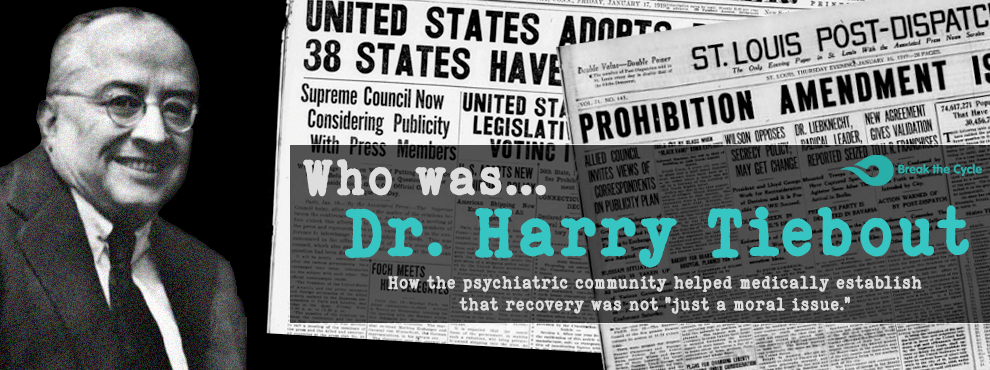
Who was Dr. Harry Tiebout? A brief professional bio…
Harry Tiebout was born on January 2, 1896, in Brooklyn, New York. He received his bachelor’s degree from Wesleyan University in 1917 and earned his doctorate from Johns Hopkins University School of Medicine. From 1922 to 1924, he worked at the Westchester Division of New York Hospital. After this, he worked in child guidance clinics in New York City, and starting in 1927 he joined the Institute for Child Guidance as a staff psychiatrist. Also at this time, he was on the staff of Cornell Medical School and the Payne Whitney Psychiatric Clinic and became the medical director of Blythewood Sanitarium in Greenwich, Connecticut.
Dr. Tiebout’s Relationship with the Early Days of Alcoholics Anonymous, “Alcoholism”, & “Alcoholics”
As Dr. Tiebout remained active in his field and continued to research and publish academic articles on A.A. and the treatment of alcoholism. His first such article, published in 1944 in The American Journal of Psychiatry, was titled “Therapeutic Mechanism of Alcoholics Anonymous.” This article served as an introduction to the A.A. program of recovery and explained A.A. to the scientific and medical communities. It demonstrated the importance of ego reduction to the alcoholic and made it clear that a religious awakening contributed to the recovery of the early A.A. members. The concept of “surrender” is repeatedly emphasized by Dr. Tiebout in this and other articles, meaning that the individual must become totally willing to accept their powerlessness and the need for help from a greater power. However, Tiebout is careful to emphasize that the alcoholic must surrender fully, rather than simply comply with the wishes of a therapist. He believed that there could be no compromise with the ego, which could always reassert itself and lead to drinking once again.
The Concept of “Compliance to Surrender”
Just what does that mean? In the realm of doing the things necessary to “stay sober or clean”; and complying with the instructions, educational concepts, modalities, suggestions, or even downright requirements from legal ramifications from our active using/drinking/etc…it seems that obviously, we must do these things to meet the goals of our recovery. So compliance isn’t a bad word, nor, does it indicate that we are doing “something wrong” or our “motives aren’t correct.” As a matter of fact, without compliance with many things in our lives, we would not receive the results we are looking for. Also, lack of compliance can come with a particular set of consequences.
Dr. Tiebout worked diligently, to better understand “alcoholism” and the “path of recovery” unfolding in the earliest of the 12-step programs that now exist today. He began to notice that acceptance and surrender took on an entirely different meaning for the people who were actively achieving long-term sobriety. The same is true today across all 12-step fellowships and programs. As well the same aspect of “acceptance and surrender” is proving to give results in long-term recovery for many within clinical settings of Intensive Outpatient Treatment, Residential, ongoing therapy for addiction/SUD/AUD counseling, etc…
Why is that? What does acceptance and surrender mean? “Tiebout credited A.A. with addressing alcoholism directly as a problem in and of itself, rather than simply as an indicator of a deeper disorder. This maintained focus on the immediate problems that were experienced by the alcoholic, which could then be addressed. He also believed that referring to alcoholism as a disease was helpful in getting an alcoholic patient to seek and accept treatment, which may be avoided if their condition was only considered a personal or moral failing.” He observed, that out of seeing the disease as a problem within itself, people had “surrendered or accepted” the condition as exactly what it is…and quickly moved into action to follow the prescribed program laid out in the 12-step process and fellowship.
Thus surrender (and even acceptance) was defined by a “willingness to move forward on the plan of action, and continue that plan for ongoing and long-term (life long) recovery -VS- simply complying to a set of instructions, rules, or measures to satisfy a set of requirements.
Therefore, Tiebout and many others from the medical community began to see that the life-long nature of the “disease” (or illness/malady) of addiction/alcoholism/SUD/AUD (and other co-occurring issues) concluded that “surrender” was ultimately validated by the persons continued actions in recovery, versus achieving objectives and ceasing continued “action”…only to find themselves back at the state of surrender from a relapse!
Maybe the whole point is to remain in an ongoing “state of surrender” and take consistent actions to mitigate the return to active use or “the first one”.
For more information and the full article on Dr. Harry Tiebout: https://www.aa.org/sites/default/files/newsletters/f-151-markings_winter-2014.pdf